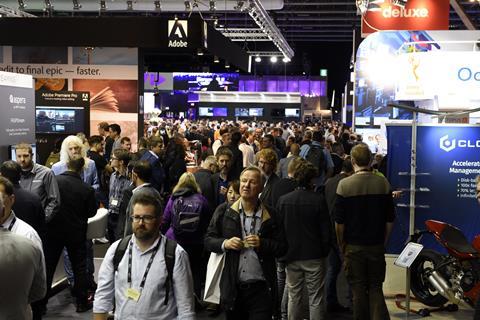Tools for creating enhanced and immersive TV, film and commercials in the form of HDR, VR and 360-degree content were on display across the halls of this year’s show, with exhibitors in Halls 6 and 7 leading the charge.

The likes of Adobe and Blackmagic Design showcased enhancements and improvements to existing software. The VR enhancements to Adobe’s Premiere Pro CC included a dedicated viewing environment in Premiere Pro. According to Adobe, editors will now be able to “experience the deeply engaging qualities of content, review their timeline and use keyboard-driven editing for trimming and markers, while wearing the same VR head-mounts as their audience”.
Sound hasn’t been overlooked; audio can be determined by orientation or position and exported as ambisonics audio for VR-enabled platforms such as YouTube and Facebook. VR effects and transitions are now native and accelerated via the Mercury playback engine.
On display at IBC was Fusion 9, billed as a “major update” to Blackmagic Design’s visual effects, compositing, 3D and motion graphics software. It includes new VR tools, entirely new keyer technology, planar tracking and camera tracking. For VR specifically, Fusion 9 features a full 360-degree 3D workspace, along with a new panoramic viewer and support for VR headsets such as the Oculus Rift and HTC Vive.
Continuing the theme of developing tools for creating richer content, Blackmagic’s Ultimatte 12 has new features for augmented reality, which the firm says is becoming more and more popular in broadcast. “For example, you often see on-air talent interacting with glass like computer generated charts, graphs, displays and other objects with colored translucency,” said Grant Petty.
Baselight 5.0, with some 50 new features, took pride of place on the Filmlight stand. One of the standout features is Base Grade, a new primary grading environment for modern colour workflows and HDR. To make the process of grading HDR swifter Filmlight has added colour space ‘families’ and a Gamut Compression tool which the London-headquartered firm said makes “moving between colour spaces simple and seamless”.
Workflow solutions
Using the cloud to create, manage and deliver content is becoming increasingly common, with Al Jazeera Media Network the latest broadcaster to make the move. At IBC, Avid announced that it has begun deploying its first hybrid cloud workflows for the Qatar-based news organisation. “As an early adopter of cloud-based workflows, we’re establishing a highly responsive and fluid global newsroom environment that better serves and engages viewers across all distribution platforms including, television, digital and mobile,” said Mohamed Abuagla, Executive Director of Technology & Operations, Al Jazeera Media Network.
An advanced convergent content monitoring system for broadcast and OTT networks was launched by Rohde and Schwarz offering real-time access to monitoring content with the support of SMPTE 2110 standard. The R&S Prismon, launched early 2017 provides a secure connection to multiple devices via a single entry point, making complex virtual private networks (VPNs) obsolete. A worldwide first at IBC2017 saw R&S Prismon monitoring use probes on mobile internet-enabled devices on a secure web service.
EditShare came to IBC with some unique products and workflow solutions on offer. Innovative EFS (EditShare File System) showcased a “game changer” for software defined media asset management with the aim of changing the way users think about workflows after recently announcing the acquisition of Quales, the QC specialist company. EditShare also scooped two industry awards from IABM and TV Tech Global for its products.
Chyronhego showcased its latest innovations during IBC, with its end-to-end production, all-software workflows running in standard IT infrastructures. Enabling broadcast news operations to run entire content creation and playout workflows in a virtualised, IT-based environment for news and sport programming. IBC2017 saw ChyronHego introduce new capabilities for VPX including an optional multi-channel SDI bridge for integration with traditional, hybrid, and IT-based infrastructures.
Meanwhile, Aspera teamed up with Telestream to launch a solution for high-speed capture and production of live, broadcast quality video from remote locations. Telestream Vantage powered by Aspera combines Aspera’s FASPStream high-speed streaming technology and Telestream Lightspeed Live Capture media processing platform to enable production teams to work on live video feeds from remote locations in near real time. According to Aspera, less than five seconds of start-up delay is required for 50 Mbps video streams transported over 250 milliseconds round-trip latency and three percent packet loss, which it says is sufficient for 4K streaming between continents.
Telestream Vice President of Enterprise Products Paul Turner said: “The solution revolutionises how media companies can approach production, capture, and post-production workflows by giving them more flexibility in the location of hardware, software and personnel.”
AJA Video Systems announced its new Io 4K Plus next generation capture and output device, with a range of connectivity on offer compatible with Ultra HD and 4K devices. The integration with mac and PC creative tools, its conversion technology facilitates real-time scaling for monitoring and output.
























No comments yet